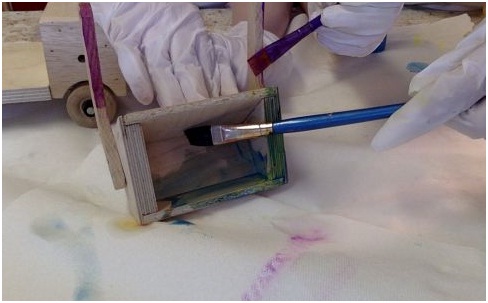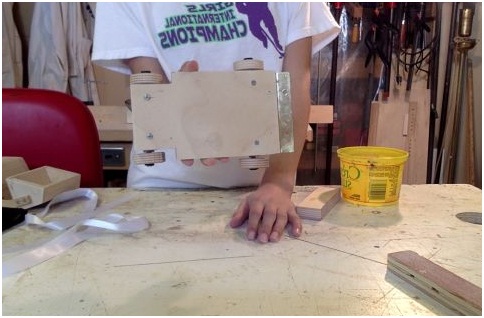





Published on Feb 13, 2025
The objective: Our project is designed to pick up trash. The simple machines we plan on using are the pulley, the inclined plane and the wheel and axle. Our invention is designed to help the environment.
What we have decided to invent a Trash Picker-Upper. The Trash Picker-Upper will pick up the trash that is in parks and other places. The Reason that we chose to event the Trash Picker-Upper is because earth is the only planet that can support life. If we don't take care of the earth we have no other place to live. So the question became how can we help the earth?
The answer was the Trash Picker-Upper. Our hypothesis that our invention will work more then times twenty-five times. We think this because it will be made out of sturdy materials so it will not get soggy or brake apart the first time you use it. In our plan we are going to use simple machines. A pulley, a inclined plane, a wheel and axle and some screws
Don’t you just love science fairs! Well Erin and I just love them. For this years science fair we are using simple machines to build compound machines to enter in the science fair. In this essay you will learn more about the six simple machines we will be using.
The inclined plane is a flat surface with one end higher than the other to gradually raise or lower objects. It is one of the 6 simple machines. The purpose of the inclined plane is to reduce force needed to raise an object. The inclined plane helps you against gravity because the object is able to move with less force. Inclined planes are everywhere.A ramp and actually a bath tub has an inclined plane which helps drain the water.
A pulley is one of the simple machines we will be using in our science fair project. A pulley is a type a wheel with a groove. The groove allows a rope or a cable to ride on a pulley without slipping off. A fixed pulley is fixed in one place and can be used to move a load up sideways, up or down. This type of pulley does not change direction of your force. A movable pulley moves the load along the rope. A movable pulley can only move a load up or down. Also this type of pulley does not change direction of your force.
A wheel and axle is a kind of a lever that rotates in a circle around the center fulcrum. How does it work? Well ,as the wheel and axle turn together, a point on the wheel moves farther than the point on the axle. Wheel and axles have lots of uses in our daily life like the wheel of your car the tap and many others. This simple machines works against friction because it turns easy so your hand does not rub against the object you are turning.
The screw is a very simple simple machine. A screw is a inclined plane wrapped around a rod. Metal screws are the most common type. and there are wooden screws too. The purpose of the screw is to help you keep materials together like screwing two pieces of wood together. The screw is to help against the force of Friction because if it was not bound together with the screw it would be loose and rubbing against each other. A type of screw is a cider press which uses screw to crush the fruit into cider and the top of a bottle cap is a screw because you screw the cap on
Levers can be classified into three categories depending on the position of the fulcrum.Levers are machines that do work by turning around a fixed point. The force you apply to a lever is called the effort. The resistance is the force exerted by the load you are trying to move. An example of a lever is a teeter totter.
Friction is a force caused by one object rubbing against the other. There are 5 different types of friction. Dry friction, fluid friction, lubricated friction, skin friction and internal friction. They each have completely different meanings.Dry friction describes the reaction between two solid bodies in contact with each other when they are in motion and when they are not (static friction). Fluid friction contributes to aerodynamic drag, which is a resistance to the forward motion of a body through a fluid (the air).Lubricated friction which resists relative lateral motion of two solid surfaces separated by a layer of gas or liquid. frictional interaction between adjacent portions in the interior of a substance due to viscous deformation or flow and resulting in the generation of heat. the part of the drag of an airplane or of the head resistance of a ship due to the friction of air or of air and water.The friction that is most common is skin friction because it is when you rub your hands together really fast and they get warm.
Gravity is a force that pulls everything to the ground. If there was no such thing as gravity we would be floating around this very moment. Some examples of gravity are when gravity pulls a roller coaster down a track or when a skier skies down a mountain. Did you know that everything and everyone has its own gravity? Before this essay I had no idea.
So you have heard all about the pulley, the inclined plane, the screw, the wheel and axle, the lever, friction and gravity. All these simple machines we are probably going to use in our project. The name of our project is the Trash Picker-Upper. And you can guess what it is going to do.
• Four ½ inch wooden wheels
• One wooden scoop
• Four wooden dowels
• One small wooden box
• One medium wooden plank
• One small wooden plank
• Two wooden levers
• Two wooden rectangular prisms with holes drilled in the middle
• 16 mm screws
• 19 mm screws
• Metal latch
• One screw with a circle for the top
• Blue paint
• Purple paint
• Paint brushes
• News paper
• 8 clear plastic washer
• 4 rubber washers
1. Take a dowel and put is through the hole drilled in the hole to make a place for the wheel.
2. Do this twice for the front and back.
3. Place a clear washer on each side of dowel so the wheel can spin easy.
4. Place the wheels on the dowels and then place another plastic washer in on the opposite side of the wheel.
5. Screw the box of the truck on to the, piece of wood with the wheels. ( with the leaver)
6. Then screw the box of the car on to the front.
7. Then attach the scoop to the car using a dowel to secure it on the car.
8. Then paint the car.
We realized that our invention would only gather trash. So we modified our invention twice too look like this. We added a scoop to the front, we also added a box to the back to hold the trash and a lever to make the box to go backward kind of like a dump truck.


During this project we learned about the simple machines: wheel and axle, screw, lever pulley, and the inclined plane. We also learned that first time plans can change unexpectedly. Another thing we learned was to use everyday tools. All the things that we learned were the most important things. But the learning about the simple machines was definitely number one.
Our question that we had to answer was how to help the environment. Our answer that we came up with was a Trash Picker-Upper. Our hypothesis that we created was that our machine would work at least 30 times. We still support our hypothesis because we have tried it at least 30 times. And all through its test runs it has worked.
Did our machine work the way we predicted,You ask? The answer is yes. Our first plan we did not build. Our second plan we did not build either. Our third invention we did build and every thing went as planned.
We made most of the changes in our first and second plans. So we would not change much. But if we were to change one thing it it would be the scoop. We would change the scoop because it was to high to pick anything up. Something useful we learned is how to use a hairdryer for drying the paint. It was a very good thing to learn. Because it would help a lot with daily life.
Sources for the simple machines we used.
1. Delta science readers, Simple Machines, Delta Education LCC, 2003
2.Amrentrout, Patricia, The Inclined Plane, The Rourke Press, Inc. Vero Beach Florida, 1997
1. Friction. (2014, April 16). In Wikipedia, The Free Encyclopedia. Retrieved 14:12, April 17, 2014, from http://en.wikipedia.org/w/index.php?title=Friction&oldid=604444354
2. Justin Cannon " Dry Friction" http://ffden-2.phys.uaf.edu/212_spring2011.web.dir/Justin_Cannon/Body1.html
3. Technological Literacy Group TM "Fluid Friction" http://www.science-of-speed.com/science.asp?id=83
4. http://en.citizendium.org/wiki/Friction_(science)
5. MW http://www.merriam-webster.com/dictionary/internal%20friction
6. MWhttp://www.merriam-webster.com/dictionary/skin%20friction